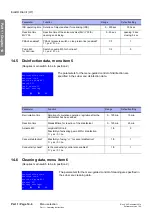
Disinfection / Cleaning
Part 1 • Page 12-17
Part 1 – Operating Instructions
Rev. 4.00 December 2014
Software version 1.04
EcoRO Dia I/II (HT)
Part 1 • Ch
apter 12
12.3.3 Sodium Hydroxide, 30% (MSDS)
Sodium Hydroxide, 30%
None.
1.43321
Other non-specified industry: Analytical reagent.
EMD Chemicals Inc.
480 S. Democrat Rd.
Gibbstown, NJ 08027
856-423-6300 Technical Service
Monday-Friday: 8:00 -5:00 PM
800-424-9300 CHEMTREC (USA)
613-996-6666 CANUTEC (Canada)
24 Hours/Day: 7 Days/Week
Material Safety Data Sheet
Product name
Supplier
Synonym
Material uses
Product code
Validation date
In case of emergency
Product and company identification
Sodium Hydroxide, 30%
:
:
:
:
:
:
:
1 .
1/28/2010.
Dermal contact. Eye contact. Inhalation. Ingestion.
Emergency overview
Hazards identification
Routes of entry
Toxic by inhalation. Severely corrosive to the respiratory system.
Severely corrosive to the eyes. Causes severe burns.
Very toxic if swallowed. May cause burns to mouth, throat and stomach.
Severely corrosive to the skin. Causes severe burns.
Eyes
Skin
Inhalation
Ingestion
Physical state
Liquid.
See toxicological information (section 11)
Do not breathe vapor or mist. Do not ingest. Do not get in eyes or on skin or clothing.
Use only with adequate ventilation. Keep container tightly closed and sealed until ready
for use. Wash thoroughly after handling.
:
:
:
:
:
:
:
Medical conditions
aggravated by over-
exposure
Pre-existing disorders involving any target organs mentioned in this MSDS as being at
risk may be aggravated by over-exposure to this product.
:
OSHA/HCS status
:
This material is considered hazardous by the OSHA Hazard Communication Standard
(29 CFR 1910.1200).
2 .
Potential chronic health effects
Carcinogenicity
:
No known significant effects or critical hazards.
No known significant effects or critical hazards.
:
Mutagenicity
Teratogenicity
:
No known significant effects or critical hazards.
No known significant effects or critical hazards.
:
Developmental effects
Fertility effects
:
No known significant effects or critical hazards.
Contains material which may cause damage to the following organs: lungs, upper
respiratory tract, skin, eyes.
:
Target organs
MAY BE FATAL IF SWALLOWED.
CAUSES SEVERE RESPIRATORY TRACT, EYE AND SKIN BURNS.
HARMFUL IF INHALED.
CONTAINS MATERIAL WHICH MAY CAUSE DAMAGE TO THE FOLLOWING
ORGANS: LUNGS, RESPIRATORY TRACT, SKIN, EYES.
DANGER!
POISON!
Continued on next page
















































